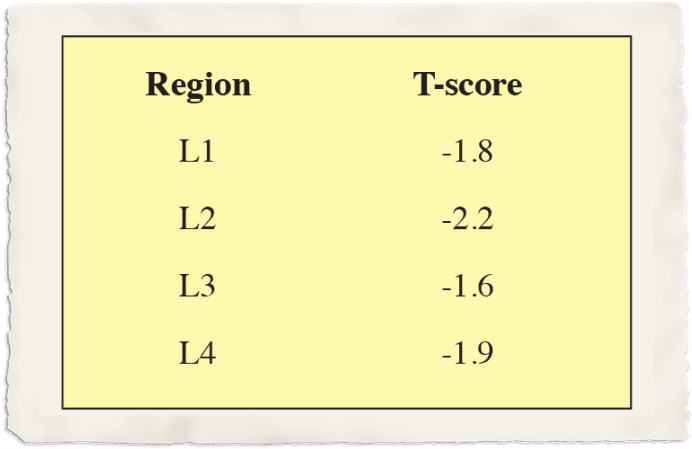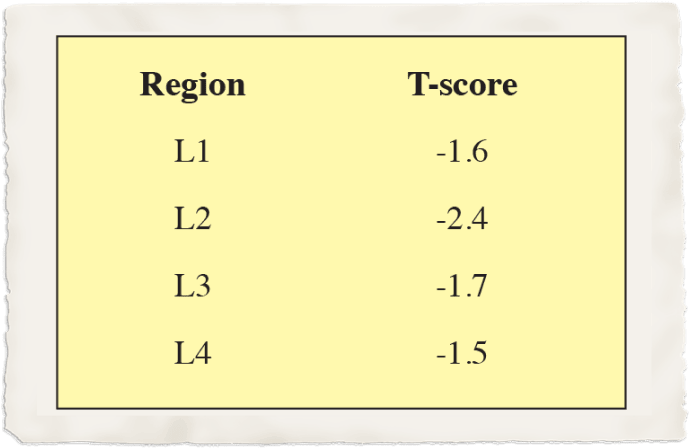Common suspects in:
Common suspects in:
Differential diagnoses for hypophosphatasia with shared symptoms:

Osteopenia/
Osteoporosis
AKA Oswaldo Porosis6-9
Note: Patient may have osteopenia as a symptom of hypophosphatasia
- Decrease in bone mineral density
- Fractures (from fragile bones)
Differential diagnoses for hypophosphatasia with shared symptoms:
Differential diagnoses for hypophosphatasia with shared symptoms:

Osteopenia/
Osteoporosis
AKA Oswaldo Porosis6-9
Note: Patient may have osteopenia as a symptom of hypophosphatasia
- Decrease in bone mineral density
- Fractures (from fragile bones)
Differential diagnoses for hypophosphatasia with shared symptoms:

Chondrocalcinosis/
pseudogout
AKA Sue Dogout10,11
Note: Patient may have pseudogout as a symptom of hypophosphatasia
- Inflammation of the joint (most commonly knee, wrist, ankle, elbow, toe, shoulder, and hip)
Differential diagnoses for hypophosphatasia with shared symptoms:

Fibromyalgia
AKA
Phil “Big Bro”
Myalgia12
- Fatigue
- Pain
- Muscle and joint stiffness
- Trouble sleeping
Differential diagnoses for hypophosphatasia with shared symptoms:

Osteogenesis
imperfecta
AKA Mr. Imperfect2,13,14
- Reduced bone density
- Bowed long bones
- Fractures
- Gracile ribs
- Metaphyseal flaring
- Brittle teeth
Differential diagnoses for hypophosphatasia with shared symptoms:

Chondrocalcinosis/
pseudogout
AKA Sue Dogout10,11
Note: Patient may have pseudogout as a symptom of hypophosphatasia
- Inflammation of the joint (most commonly knee, wrist, ankle, elbow, toe, shoulder, and hip)
Differential diagnoses for hypophosphatasia with shared symptoms:

Fibromyalgia
AKA
Phil “Big Bro”
Myalgia12
- Fatigue
- Pain
- Muscle and joint stiffness
- Trouble sleeping
Differential diagnoses for hypophosphatasia with shared symptoms:

Osteogenesis
imperfecta
AKA Mr. Imperfect2,13,14
- Reduced bone density
- Bowed long bones
- Fractures
- Gracile ribs
- Metaphyseal flaring
- Brittle teeth
View the full list of suspects, shared symptoms, and how to differentiate from hypophosphatasia:
INFANTILE/PEDIATRIC MISDIAGNOSES1,2
Differential diagnoses for hypophosphatasia (HPP)
Shared symptoms
How to differentiate from
hypophosphatasia
Osteogenesis imperfecta (OI)1,3-7
- Reduced bone density
- Deficient ossification of skull
vault - Bowed long bones
- Fractures
- Gracile ribs
- Narrow thorax
- Metaphyseal flaring
- Widening of growth plates
- Brittle teeth
- Test for persistently low alkaline phosphatase (alkaline phosphatase is normal or transiently low in OI)
-
Radiographs may help distinguish from hypophosphatasia
- Wormian bones of the skull and compression fractures in the spine are common in OI but not in hypophosphatasia
- Can support diagnosis with genetic testing
- Clinical history and physical exam
Campomelic dysplasia (CD)1,6,8-11
- Shortening, bowing, and
angulation of the long bones - Diaphyseal spurs
- Tibial dimple
- Absent ossification of
pedicles - Hypoplastic fibula
- Test for persistently low alkaline phosphatase (alkaline phosphatase is low in severe patients)
-
Radiographs may help distinguish from hypophosphatasia
- CD has sites of long bone angulation (femur and tibia), lacks ossification of the wings of scapula, dislocated elbow, 11 pairs of ribs, narrow iliac wings, and normal bone density
- Can support diagnosis with genetic testing
- Clinical history and physical exam
Chondrodysplasias6,7,9,12,13
- Short stature and vertebral abnormalities
- Test for persistently low alkaline phosphatase
- Radiographs may help distinguish from hypophosphatasia
- Clinical history and physical exam
Nutritional rickets1,5,7,13-16,19
- Development of bone
deformities - Failure of bone mineralization
- Bowed legs
- Delay in gross motor
milestones
- Test for persistently low alkaline phosphatase (alkaline phosphatase is high in rickets)
-
Test for vitamin B6, calcium, vitamin D, and
parathyroid hormone
- Patients may have normal vitamin B6 and urine PEA
- Clinical history and physical exam
Differential diagnoses for hypophosphatasia (HPP)
Shared symptoms
How to differentiate from
hypophosphatasia
Cleidocranial dysostosis1,5,7,13,16,17
- Abnormality of the dentition
- Narrow chest
- Recurrent respiratory infections
- Short stature
- Skeletal dysplasia osteoporosis
- Test for persistently low alkaline phosphatase (alkaline phosphatase may be low in severe patients)
- Test for vitamin B6, calcium, vitamin D, and parathyroid hormone
- Patients may have normal vitamin B6 and urine PEA
- Radiographs may help distinguish from hypophosphatasia
- Clinical history and physical exam
Craniosynostosis1,7,9,16,18-20
- Bones in skull fuse together too early
- Test for persistently low alkaline phosphatase
-
Test for vitamin B6, calcium, vitamin D, and parathyroid hormone
- Patients may have normal vitamin B6 and urine PEA
- Radiographs may help distinguish from hypophosphatasia
- Clinical history and physical exam
Idiopathic juvenile osteoporosis1,7,16,19,21,22
- Fractures
- Bone pain
- Difficulty/inability to walk
- Test for persistently low alkaline phosphatase (alkaline phosphatase is normal in idiopathic juvenile osteoporosis)
-
Test for vitamin B6, calcium, vitamin D, and
parathyroid hormone
- Patients may have normal vitamin B6 and urine PEA
- Radiographs may help distinguish from hypophosphatasia
- Clinical history and physical exam
X-linked hypophosphatemia (XLH)1,5,7,16,19,23
- Bone pain
- Bowing of the legs
- Delayed ability to walk
- Growth delay
- Reduced bone mineral density
- Test for persistently low alkaline phosphatase (alkaline phosphatase is high in XLH)
- Test for vitamin B6, calcium, vitamin D, and parathyroid hormone
- Patients may have normal vitamin B6 and urine PEA
- Clinical history and physical exam
Ehlers-Danlos syndrome9,11,24,25
- Joint hypermobility
- Connective tissue fragility
- Dentin structural irregularities
- Joint pain
- Test for persistently low alkaline phosphatase
- Skin biopsies can help with diagnosis
- Radiographs may help distinguish from hypophosphatasia
- Genetic testing may help support a hypophosphatasia diagnosis, but a hypophosphatasia diagnosis cannot be excluded by not finding an ALPL mutation
References
ADULT MISDIAGNOSES
Differential diagnoses for hypophosphatasia (HPP)
Shared symptoms
How to differentiate from
hypophosphatasia
Osteogenesis imperfecta (OI)1-6
- Reduced bone density
- Bowed long bones
- Fractures
- Gracile ribs
- Narrow thorax
- Metaphyseal flaring
- Brittle teeth
- Test for persistently low alkaline phosphatase (alkaline phosphatase is normal or transiently low in OI)
- Radiographs may help distinguish from hypophosphatasia
- Can support diagnosis with genetic testing
- Clinical history and physical exam
Osteopenia/osteoporosis4,7-10
Note: Patient may have osteopenia as a symptom of hypophosphatasia11
- Decrease in bone mineral
density - Fractures (from fragile bones)
- Test for persistently low alkaline phosphatase (may be high in men with osteoporosis)
- Test for vitamin B6 and urine PEA
-
Radiographs may help distinguish from
hypophosphatasia
- DXA may help support a hypophosphatasia diagnosis
- Genetic testing may help support a hypophosphatasia diagnosis, but a hypophosphatasia diagnosis cannot be excluded by not finding an ALPL mutation
Chondrocalcinosis/
pseudogout10,12-14
Note: Patient may have pseudogout as a symptom of hypophosphatasia15
-
Inflammation of the joint
(most commonly knee,
wrist, ankle, elbow, toe,
shoulder, and hip)
- Test for persistently low alkaline phosphatase
- Arthrocentesis and synovial fluid analysis can confirm diagnosis
-
Radiographs may help distinguish from
hypophosphatasia
- DXA may help support a hypophosphatasia diagnosis
- Genetic testing may help support a hypophosphatasia diagnosis, but a hypophosphatasia diagnosis cannot be excluded by not finding an ALPL mutation
Osteoarthritis10,13,16-18
- Joint pain
- Limited mobility
- Test for persistently low alkaline phosphatase (may be elevated in patients with osteoarthritis)
-
Radiographs may help distinguish from
hypophosphatasia
- DXA may help support a hypophosphatasia diagnosis
- Genetic testing may help support a hypophosphatasia diagnosis, but a hypophosphatasia diagnosis cannot be excluded by not finding an ALPL mutation
Fibromyalgia10,14,19,20
- Fatigue
- Pain
- Muscle and joint stiffness
- Test for persistently low alkaline phosphatase (may present as normal)
- Radiographs may help distinguish from hypophosphatasia
- Genetic testing may help support a hypophosphatasia diagnosis, but a hypophosphatasia diagnosis cannot be excluded by not finding an ALPL mutation
Differential diagnoses for hypophosphatasia (HPP)
Shared symptoms
How to differentiate from
hypophosphatasia
Ehlers-Danlos syndrome10,13,14,18-20
- Joint hypermobility
- Connective tissue fragility
- Dentin structural irregularities
- Joint pain
- Test for persistently low alkaline phosphatase
- Skin biopsies can help with diagnosis
- Radiographs may help distinguish from hypophosphatasia
- Genetic testing may help support a hypophosphatasia diagnosis, but a hypophosphatasia diagnosis cannot be excluded by not finding an ALPL mutation
RISK OF TREATMENT
Treatments for differential diagnoses
Patient
populations
Risk of treatment in patients with hypophosphatasia
Bisphosphonates
- Bisphosphonates are commonly used in adult patients with osteoporosis21
Based on a study examining bisphosphonates in osteoporosis, the half-life of bisphosphonates was shown to be greater than 10 years and may have detrimental effects on a patient's condition if a wrongful diagnosis is made. Make sure to rule out hypophosphatasia before starting patients on bisphosphonates.22
- Bisphosphonates are commonly used in adult patients with osteoporosis21,23,24
- Possible increased risk of fracture at growth plate21,23,24
- Increased risk of atypical femoral fractures in adults21,23,24
- Excessively high doses have led to osteopetrosis and persistent remodeling defects, persisting more than 6 years after discontinuation21,23,24
- The phosphate motifs in bisphosphonates have a similar conformation to inorganic pyrophosphate (PPi), with the accumulation of PPi associated with skeletal and systemic symptoms seen in HPP, which may ultimately result in a worsening of presenting symptoms21,23,24
- Bisphosphonates may directly or indirectly worsen HPP by binding zinc or magnesium, compromising ALP activity21,23,24
Supplements:
Vitamin D and calcium
- Vitamin D and calcium supplementation can be used for a myriad of conditions, ranging from rickets to depression, in adults, children, and infants7,23,25
- Hypercalcemia7,23,25
- Hypercalciuria7,23,25
- Kidney stones7,23,25
References
INFANTILE/PEDIATRIC
MISDIAGNOSES1,2
Differential diagnoses for
hypophosphatasia (HPP)
Expand All
Osteogenesis imperfecta (OI)1,3-7
Shared symptoms
- Reduced bone density
- Deficient ossification of skull vault
- Bowed long bones
- Fractures
- Gracile ribs
- Narrow thorax
- Metaphyseal flaring
- Widening of growth plates
- Brittle teeth
How to differentiate from
hypophosphatasia
- Test for persistently low alkaline phosphatase (alkaline phosphatase is normal or transiently low in OI)
- Radiographs may help distinguish from hypophosphatasia
-
- Wormian bones of the skull and compression fractures in the spine are common in OI but not in hypophosphatasia
- Can support diagnosis with genetic testing
- Clinical history and physical exam
Campomelic dysplasia (CD) 1,6,8-11
Shared symptoms
- Shortening, bowing, and angulation of the long bones
- Diaphyseal spurs
- Tibial dimple
- Absent ossification of pedicles
- Hypoplastic fibula
How to differentiate from
hypophosphatasia
- Test for persistently low alkaline phosphatase (alkaline phosphatase is low in severe patients)
- Radiographs may help distinguish from hypophosphatasia
-
- CD has sites of long bone angulation (femur and tibia), lacks ossification of the wings of scapula, dislocated elbow, 11 pairs of ribs, narrow iliac wings, and normal bone density
- Can support diagnosis with genetic testing
- Clinical history and physical exam
Chondrodysplasias6,7,9,12,13
Shared symptoms
- Short stature and vertebral abnormalities
How to differentiate from HPP
- Test for persistently low alkaline phosphatase
- Radiographs may help distinguish from hypophosphatasia
- Clinical history and physical exam
Nutritional rickets1,5,7,13-16,19
Shared symptoms
- Development of bone deformities
- Failure of bone mineralization
- Bowed legs
- Delay in gross motor milestones
How to differentiate from
hypophosphatasia
- Test for persistently low alkaline phosphatase (alkaline phosphatase is high in rickets)
- Test for vitamin B6, calcium, vitamin D, and parathyroid hormone
-
- Patients may have normal vitamin B6 and urine PEA
- Clinical history and physical exam
Cleidocranial dysostosis 1,5,7,13,16,17
Shared symptoms
- Abnormality of the dentition
- Narrow chest
- Recurrent respiratory infections
- Short stature
- Skeletal dysplasia osteoporosis
How to differentiate from
hypophosphatasia
- Test for persistently low alkaline phosphatase (alkaline phosphatase may be low in severe patients)
- Test for vitamin B6, calcium, vitamin D, and parathyroid hormone
- Patients may have normal vitamin B6 and urine PEA
- Radiographs may help distinguish from hypophosphatasia
- Clinical history and physical exam
Craniosynostosis1,7,9,16,18-20
Shared symptoms
- Bones in skull fuse together too early
How to differentiate from
hypophosphatasia
- Test for persistently low alkaline phosphatase
- Test for vitamin B6, calcium, vitamin D, and parathyroid hormone
-
- Patients may have normal vitamin B6 and urine PEA
- Radiographs may help distinguish from hypophosphatasia
- Clinical history and physical exam
Idiopathic juvenile osteoporosis1,7,16,19,21,22
Shared symptoms
- Fractures
- Bone pain
- Difficulty/inability to walk
How to differentiate from
hypophosphatasia
- Test for persistently low alkaline phosphatase (alkaline phosphatase is normal in idiopathic juvenile osteoporosis)
- Test for vitamin B6, calcium, vitamin D, and parathyroid hormone
-
- Patients may have normal vitamin B6 and urine PEA
- Radiographs may help distinguish from hypophosphatasia
- Clinical history and physical exam
X-linked hypophosphatemia (XLH)1,5,7,16,19,23
Shared symptoms
- Bone pain
- Bowing of the legs
- Delayed ability to walk
- Growth delay
- Reduced bone mineral density
How to differentiate from
hypophosphatasia
- Test for persistently low alkaline phosphatase (alkaline phosphatase is high in XLH)
- Test for vitamin B6, calcium, vitamin D, and parathyroid hormone
- Patients may have normal vitamin B6 and urine PEA
- Clinical history and physical exam
Ehlers-Danlos syndrome9,11,24,25
Shared symptoms
- Joint hypermobility
- Connective tissue fragility
- Dentin structural irregularities
- Joint pain
How to differentiate from
hypophosphatasia
- Test for persistently low alkaline phosphatase
- Skin biopsies can help with diagnosis
- Radiographs may help distinguish from hypophosphatasia
- Genetic testing may help support a hypophosphatasia diagnosis, but a hypophosphatasia diagnosis cannot be excluded by not finding an ALPL mutation
References
1. Offiah AC, Vockley J, Munns CF, Murotsuki J. Differential diagnosis of perinatal hypophosphatasia: radiologic perspectives. Pediatr Radiol. 2019;49(1)3-22. 2. Mornet E, Hofmann C, Bloch-Zupan A, Girschick H, Le Merrer M. Clinical utility gene card for: hypophosphatasia – update 2013. Eur J Hum Gen. 2014;22(4). 3. National Institute of Child Health and Human Development. What are the symptoms of osteogenesis imperfecta (OI). Accessed March 30, 2023. https://www.nichd.nih.gov/health/topics/osteogenesisimp/conditioninfo/symptoms 4. Marini JC, Cabral WA. Osteogenesis imperfecta. In: Thakker RV, Whyte MP, Eisman JA, Igarashi T, eds. Genetics of Bone Biology and Skeletal Disease. 2nd ed. Academic Press; 2018;397-420. 5. Bloch-Zupan A. Hypophosphatasia: diagnosis and clinical signs - a dental surgeon perspective. Int J Paediatr Dent. 2016;26(6):426-438. 6. Taillandier A, Domingues C, De Cazanove C, et al. Molecular diagnosis of hypophosphatasia and differential diagnosis by targeted Next Generation Sequencing. Mol Genet Metab. 2015;116(3):215-220. 7. Duffus S, Thrasher B, Calikoglu AS. Brief clinical report: hypophosphatasia–diagnostic considerations and treatment outcomes in an infant. Case Rep Pediatr. 2018;2018:5719761. 8. National Institutes of Health. Campomelic dysplasia. Accessed March 17, 2023. https://rarediseases.info.nih.gov/diseases/10027/campomelic-dysplasia 9. Simon S, Resch H, Klaushofer K, Roschger P, Zwerina J, Kocijan R. Hypophosphatasia: from diagnosis to treatment. Curr Rheumatol Rep. 2018;20(11):69. 10. Macmullan P, McCarthy G. Treatment and management of pseudogout: insights for the clinician. Ther Adv Musculoskelet Dis. 2012;4(2):121-131. 11. Villa-Suárez JM, García-Fontana C, Andújar-Vera F, et al. Hypophosphatasia: a unique disorder of bone mineralization. Int J Mol Sci. 2021;22(9):4303. 12. Dubail J, Cormier-Daire V. Chondrodysplasias with multiple dislocations caused by defects in glycosaminoglycan synthesis. Front Genet. 2021;12:642097. 13. Mohn A, De Leonibus C, de Giorgis T, Mornet E, Chiarelli F. Hypophosphatasia in a child with widened anterior fontanelle: lessons learned from late diagnosis and incorrect treatment. Acta Paediatr. 2011;100(7):e43-e46. 14. Tournis S, Yavropoulou MP, Polyzos SA, Doulgeraki A. Hypophosphatasia. J Clin Med. 2021;10(23):5676. 15. Pettifor JM. Nutritional rickets. In: Glorieux FH, Pettifor JM, Jüppner H, eds. Pediatric Bone. 2nd ed. Academic Press; 2012:625-654. 16. Mckiernan FE, Dong J, Berg RL, et al. Mutational and biochemical findings in adults with persistent hypophosphatasemia. Osteoporos Int. 2017;28:2343-2348. 17. Genetic and Rare Disease Information Center. Cleidocranial dysplasia. Accessed March 30, 2023. https://rarediseases.info.nih.gov/diseases/6118/cleidocranial-dysplasia 18. Center of Disease Control. Facts about craniosynostosis. Accessed March 30, 2023. https://www.cdc.gov/ncbddd/birthdefects craniosynostosis.html#:~:text=What%20is%20Craniosynostosis 19. Nunes ME. Hypophosphatasia. In: Adam MP, Ardinger HH, Pagon RA, et al, eds. GeneReviews®. University of Washington; 2007. Accessed March 30, 2023. http://www.ncbi.nlm.nih.gov/books/NBK1150/ 20. Rockman-Greenberg C. Hypophosphatasia. Pediatr Endocrinol Rev. 2013;10(suppl 2):380-388. 21. Imerci A, Canbek U, Haghari S, Surer L, Kocak M. Idiopathic juvenile osteoporosis: a case report and review of the literature. Int J Surg Case Rep. 2015;9;127-129. 22. Kulkarni ML, Keshavamurthy KS. Juvenile idiopathic osteoporosis. Indian Pediatr. 2004;41(7):737-740. 23. Genetic and Rare Disease Information Center. X-linked hypophosphatemia. Accessed March 30, 2023. https://rarediseases.info.nih.gov/diseases/12943/x-linked-hypophosphatemia 24. Abel MD, Carrasco LR. Ehlers-Danlos syndrome: classifications, oral manifestations, and dental considerations. Oral Surg Oral Med Oral Pathol Oral Radiol Endod. 2006;102(5):582-590. 25. Sobey G. Ehlers-Danlos syndrome: how to diagnose and when to perform genetic tests. Arch Dis Child. 2015;100(1):57-61.
Adult misdiagnoses
Differential diagnoses for
hypophosphatasia (HPP)
Expand All
Osteogenesis imperfecta (OI)1-6
Shared symptoms
- Reduced bone density
- Bowed long bones
- Fractures
- Gracile ribs
- Narrow thorax
- Metaphyseal flaring
- Brittle teeth
How to differentiate from
hypophosphatasia
- Test for persistently low alkaline phosphatase (alkaline phosphatase is normal or transiently low in OI)
- Radiographs may help distinguish from hypophosphatasia
- Can support diagnosis with genetic testing
- Clinical history and physical exam
Osteopenia/osteoporosis4,7-10
Note: Patient may have osteopenia as a symptom of hypophosphatasia11
Shared symptoms
- Decrease in bone mineral density
- Fractures (from fragile bones)
How to differentiate from
hypophosphatasia
- Test for persistently low alkaline phosphatase (may be high in men with osteoporosis)
- Test for vitamin B6 and urine PEA
- Radiographs may help distinguish from hypophosphatasia
-
- DXA may help support a hypophosphatasia diagnosis
- Genetic testing may help support a hypophosphatasia diagnosis, but a hypophosphatasia diagnosis cannot be excluded by not finding an ALPL mutation
Chondrocalcinosis/pseudogout10,12-14
Note: Patient may have pseudogout as a symptom of hypophosphatasia15
Shared symptoms
- Inflammation of the joint (most commonly knee, wrist, ankle, elbow, toe, shoulder, and hip)
How to differentiate from
hypophosphatasia
- Test for persistently low alkaline phosphatase
- Arthrocentesis and synovial fluid analysis can confirm diagnosis
- Radiographs may help distinguish from hypophosphatasia
-
- DXA may help support a hypophosphatasia diagnosis
- Genetic testing may help support a hypophosphatasia diagnosis, but a hypophosphatasia diagnosis cannot be excluded by not finding an ALPL mutation
Osteoarthritis10,13,16-18
Shared symptoms
- Joint pain
- Limited mobility
How to differentiate from
hypophosphatasia
- Test for persistently low alkaline phosphatase (may be elevated in patients with osteoarthritis)
- Radiographs may help distinguish from hypophosphatasia
-
- DXA may help support a hypophosphatasia diagnosis
- Genetic testing may help support a hypophosphatasia diagnosis, but a hypophosphatasia diagnosis cannot be excluded by not finding an ALPL mutation
Fibromyalgia 10,14,19-20
Shared symptoms
- Fatigue
- Pain
- Muscle and joint stiffness
How to differentiate from
hypophosphatasia
- Test for persistently low alkaline phosphatase (may present as normal)
- Radiographs may help distinguish from hypophosphatasia
- Genetic testing may help support a hypophosphatasia diagnosis, but a hypophosphatasia diagnosis cannot be excluded by not finding an ALPL mutation
Ehlers-Danlos syndrome10,13,14,18-20
Shared symptoms
- Joint hypermobility
- Connective tissue fragility
- Dentin structural irregularities
- Joint pain
How to differentiate from
hypophosphatasia
- Test for persistently low alkaline phosphatase
- Skin biopsies can help with diagnosis
- Radiographs may help distinguish from hypophosphatasia
- Genetic testing may help support a hypophosphatasia diagnosis, but a hypophosphatasia diagnosis cannot be excluded by not finding an ALPL mutation
Risk of treatment
Treatments for
differential diagnoses
Expand All
Bisphosphonates
Patient Populations
- Bisphosphonates are commonly used in adult patients with osteoporosis21
Risk of treatment in patients with hypophosphatasia
The half-life of bisphosphonates can exceed 10 years and may have detrimental effects on a patient’s condition if a wrongful diagnosis is made. Make sure to rule out hypophosphatasia before starting patients on bisphosphonates.22
- Bisphosphonates are commonly used in adult patients with osteoporosis21,23,24
- Possible increased risk of fracture at growth plate21,23,24
- Increased risk of atypical femoral fractures in adults21,23,24
- Excessively high doses have led to osteopetrosis and persistent remodeling defects, persisting more than 6 years after discontinuation21,23,24
- The phosphate motifs in bisphosphonates have a similar conformation to inorganic pyrophosphate (PPi), with the accumulation of PPi associated with skeletal and systemic symptoms seen in HPP, which may ultimately result in a worsening of presenting symptoms21,23,24
- Bisphosphonates may directly or indirectly worsen HPP by binding zinc or magnesium, compromising ALP activity21,23,24
Supplements:
Vitamin D and calcium
Shared symptoms
- Vitamin D and calcium supplementation can be used for a myriad of conditions, ranging from rickets to depression, in adults, children, and infants.7,23,25
Risk of treatment in patients
with hypophosphatasia
- Hypercalcemia7,23,25
- Hypercalciuria7,23,25
- Kidney stones7,23,25
References
1. National Institute of Child Health and Human Development. What are the symptoms of osteogenesis imperfecta (OI). Accessed March 30, 2023. https://www.nichd.nih.gov/health/topics/osteogenesisimp/conditioninfo/symptoms 2. Marini JC, Cabral WA. Osteogenesis Imperfecta. In: Thakker RV, Whyte MP, Eisman JA, Igarashi T, eds. Genetics of Bone Biology and Skeletal Disease. 2nd ed. Academic Press; 2018:397-420. 3. Offiah AC, Vockley J, Munns CF, Murotsuki J. Differential diagnosis of perinatal hypophosphatasia: radiologic perspectives. Pediatr Radiol. 2019;49(1):3-22. 4. Bloch-Zupan A. Hypophosphatasia: diagnosis and clinical signs - a dental surgeon perspective. Int J Paediatr Dent. 2016;26(6):426-438. 5. Taillandier A, Domingues C, De Cazanove C, et al. Molecular diagnosis of hypophosphatasia and differential diagnosis by targeted Next Generation Sequencing. Mol Genet Metab. 2015;116(3):215-220. 6. Duffus S, Thrasher B, Calikoglu AS. Brief clinical report: hypophosphatasia–diagnostic considerations and treatment outcomes in an infant. Case Rep Pediatr. 2018;2018:5719761. 7. Shapiro JR, Lewiecki EM. Hypophosphatasia in adults: clinical assessment and treatment considerations. J Bone Miner Res. 2017;32(10):1977-1980. 8. Desborough R, Nicklin P, Gossiel F, et al. Clinical and biochemical characteristics of adults with hypophosphatasia attending a metabolic bone clinic. Bone. 2021;144:115795. 9. Fink HA, Litwack-Harrison S, Taylor BC, et al. Clinical utility of routine laboratory testing to identify possible secondary causes in older men with osteoporosis: the Osteoporotic Fractures in Men (MrOS) Study. Osteoporos Int. 2016;27(1):331-338. 10. Villa-Suárez JM, García-Fontana C, Andújar-Vera F, et al. Hypophosphatasia: a unique disorder of bone mineralization. Int J Mol Sci. 2021;22(9):4303. 11. Varacallo M, Seaman TJ, Jandu JS, et al. Osteopenia. StatPearls [Internet]. 2022. Accessed March 30, 2023. https://www.ncbi.nlm.nih.gov/books/NBK499878/ 12. Macmullan P, McCarthy G. Treatment and management of pseudogout: insights for the clinician. Ther Adv Muscoloskel Dis. 2012;4(2):121-131. 13. Tournis S, Yavropoulou MP, Polyzos SA, Doulgeraki A. Hypophosphatasia. J Clin Med. 2021;10(23):5676. 14. Simon S, Resch H, Klaushofer K, Roschger P, Zwerina J, Kocijan R. Hypophosphatasia: from diagnosis to treatment. Curr Rheumatol Rep. 2018;20(11):69. 15. Rosenthal AK, Ryan LM. Calcium pyrophosphate deposition disease. N Engl J Med. 2016;374(26):2575-2584. 16. National Institute of Arthritis and Musculoskeletal and Skin Diseases. Osteoarthritis. Accessed March 30, 2023. https://www.niams.nih.gov/health-topics/osteoarthritis 17. Park HM, Lee JH, Lee YJ. Positive association of serum alkaline phosphatase level with severe knee osteoarthritis: a nationwide population-based study. Diagnostics (Basel). 2020;10(12):1016. 18. Kishnani PS, Rush ET, Arudne P, et al. Monitoring guidance for patients with hypophosphatasia treated with asfotase alfa. Mol Genet Metab. 2017;122(1-2):4-17. 19. Abel MD, Carrasco LR. Ehlers-Danlos syndrome: classifications, oral manifestations, and dental considerations. Oral Surg Oral Med Oral Pathol Oral Radiol Endod. 2006;102(5):582-590. 20. Sobey G. Ehlers-Danlos syndrome: how to diagnose and when to perform genetic tests. Arch Dis Child. 2015;100(1):57-61. 21. Boyce AM, Tosi LL, Paul SM. Bisphosphonate treatment for children with disabling conditions. PM R. 2014;6(5):427-436. 22. Stadecker WJ. Bisphosphonates 101: an update for the general dentist. Inside Dentistry. 2008. 23. Bianchi ML, Bishop NJ, Guañabens N, et al; Rare Bone Disease Action Group of the European Calcified Tissue Society. Hypophosphatasia in adolescents and adults: overview of diagnosis and treatment. Osteoporos Int. 2020;31(8):1445-1460. 24. Choida V, Bubbear JS. Update on the management of hypophosphatasia. Ther Adv Musculoskelet Dis. 2019;11:1759720X19863997. 25. Martos-Moreno GA, Calzada J, Couce ML, Argente J. Hypophosphatasia: clinical manifestations, diagnostic recommendations and therapeutic options. An Pediatr (Engl Ed). 2018;88(6):356.e1-356.e11.
Differential diagnoses for hypophosphatasia with shared symptoms:

Osteogenesis
imperfecta
AKA Mr. Imperfect2,6,7
- Reduced bone density
- Bowed long bones
- Fractures
- Gracile ribs
- Metaphyseal flaring
- Brittle teeth
Differential diagnoses for hypophosphatasia with shared symptoms:
Differential diagnoses for hypophosphatasia with shared symptoms:

Osteogenesis
imperfecta
AKA Mr. Imperfect2,6,7
- Reduced bone density
- Bowed long bones
- Fractures
- Gracile ribs
- Metaphyseal flaring
- Brittle teeth
Differential diagnoses for hypophosphatasia with shared symptoms:

Nutritional rickets
AKA Tricky Ricky8
- Development of bone deformities
- Failure of bone mineralization
- Bowed legs
- Delay in gross motor milestones
Differential diagnoses for hypophosphatasia with shared symptoms:

X-linked
hypophosphatemia
AKA X-Woman9,10
- Bone pain
- Bowing of the legs
- Delayed ability to walk
- Growth delay
- Reduced bone mineral density
Differential diagnoses for hypophosphatasia with shared symptoms:

Cleidocranial
dysostosis
AKA Cleo11
- Abnormality of the dentition
- Narrow chest
- Recurrent respiratory infections
- Short stature
- Skeletal dysplasia osteoporosis
Differential diagnoses for hypophosphatasia with shared symptoms:

Campomelic dysplasia
AKA Shorty2,12
- Shortening, bowing, and angulation of the long bones
- Tibial dimple
Differential diagnoses for hypophosphatasia with shared symptoms:

Nutritional rickets
AKA Tricky Ricky8
- Development of bone deformities
- Failure of bone mineralization
- Bowed legs
- Delay in gross motor milestones
Differential diagnoses for hypophosphatasia with shared symptoms:

X-linked
hypophosphatemia
AKA X-Woman9,10
- Bone pain
- Bowing of the legs
- Delayed ability to walk
- Growth delay
- Reduced bone mineral density
Differential diagnoses for hypophosphatasia with shared symptoms:

Cleidocranial
dysostosis
AKA Cleo11
- Abnormality of the dentition
- Narrow chest
- Recurrent respiratory infections
- Short stature
- Skeletal dysplasia osteoporosis
Differential diagnoses for hypophosphatasia with shared symptoms:

Campomelic dysplasia
AKA Shorty2,12
- Shortening, bowing, and angulation of the long bones
- Tibial dimple
View the full list of suspects, shared symptoms, and how to differentiate from hypophosphatasia:
INFANTILE/PEDIATRIC
MISDIAGNOSES1,2
Differential diagnoses for
hypophosphatasia (HPP)
Expand All
Osteogenesis imperfecta (OI)1,3-7
Shared symptoms
- Reduced bone density
- Deficient ossification of skull vault
- Bowed long bones
- Fractures
- Gracile ribs
- Narrow thorax
- Metaphyseal flaring
- Widening of growth plates
- Brittle teeth
How to differentiate from
hypophosphatasia
- Test for persistently low alkaline phosphatase (alkaline phosphatase is normal or transiently low in OI)
- Radiographs may help distinguish from hypophosphatasia
-
- Wormian bones of the skull and compression fractures in the spine are common in OI but not in hypophosphatasia
- Can support diagnosis with genetic testing
- Clinical history and physical exam
Campomelic dysplasia (CD) 1,6,8-11
Shared symptoms
- Shortening, bowing, and angulation of the long bones
- Diaphyseal spurs
- Tibial dimple
- Absent ossification of pedicles
- Hypoplastic fibula
How to differentiate from
hypophosphatasia
- Test for persistently low alkaline phosphatase (alkaline phosphatase is low in severe patients)
- Radiographs may help distinguish from hypophosphatasia
-
- CD has sites of long bone angulation (femur and tibia), lacks ossification of the wings of scapula, dislocated elbow, 11 pairs of ribs, narrow iliac wings, and normal bone density
- Can support diagnosis with genetic testing
- Clinical history and physical exam
Chondrodysplasias6,7,9,12,13
Shared symptoms
- Short stature and vertebral abnormalities
How to differentiate from HPP
- Test for persistently low alkaline phosphatase
- Radiographs may help distinguish from hypophosphatasia
- Clinical history and physical exam
Nutritional rickets1,5,7,13-16,19
Shared symptoms
- Development of bone deformities
- Failure of bone mineralization
- Bowed legs
- Delay in gross motor milestones
How to differentiate from
hypophosphatasia
- Test for persistently low alkaline phosphatase (alkaline phosphatase is high in rickets)
- Test for vitamin B6, calcium, vitamin D, and parathyroid hormone
-
- Patients may have normal vitamin B6 and urine PEA
- Clinical history and physical exam
Cleidocranial dysostosis 1,5,7,13,16,17
Shared symptoms
- Abnormality of the dentition
- Narrow chest
- Recurrent respiratory infections
- Short stature
- Skeletal dysplasia osteoporosis
How to differentiate from
hypophosphatasia
- Test for persistently low alkaline phosphatase (alkaline phosphatase may be low in severe patients)
- Test for vitamin B6, calcium, vitamin D, and parathyroid hormone
- Patients may have normal vitamin B6 and urine PEA
- Radiographs may help distinguish from hypophosphatasia
- Clinical history and physical exam
Craniosynostosis1,7,9,16,18-20
Shared symptoms
- Bones in skull fuse together too early
How to differentiate from
hypophosphatasia
- Test for persistently low alkaline phosphatase
- Test for vitamin B6, calcium, vitamin D, and parathyroid hormone
-
- Patients may have normal vitamin B6 and urine PEA
- Radiographs may help distinguish from hypophosphatasia
- Clinical history and physical exam
Idiopathic juvenile osteoporosis1,7,16,19,21,22
Shared symptoms
- Fractures
- Bone pain
- Difficulty/inability to walk
How to differentiate from
hypophosphatasia
- Test for persistently low alkaline phosphatase (alkaline phosphatase is normal in idiopathic juvenile osteoporosis)
- Test for vitamin B6, calcium, vitamin D, and parathyroid hormone
-
- Patients may have normal vitamin B6 and urine PEA
- Radiographs may help distinguish from hypophosphatasia
- Clinical history and physical exam
X-linked hypophosphatemia (XLH)1,5,7,16,19,23
Shared symptoms
- Bone pain
- Bowing of the legs
- Delayed ability to walk
- Growth delay
- Reduced bone mineral density
How to differentiate from
hypophosphatasia
- Test for persistently low alkaline phosphatase (alkaline phosphatase is high in XLH)
- Test for vitamin B6, calcium, vitamin D, and parathyroid hormone
- Patients may have normal vitamin B6 and urine PEA
- Clinical history and physical exam
Ehlers-Danlos syndrome9,11,24,25
Shared symptoms
- Joint hypermobility
- Connective tissue fragility
- Dentin structural irregularities
- Joint pain
How to differentiate from
hypophosphatasia
- Test for persistently low alkaline phosphatase
- Skin biopsies can help with diagnosis
- Radiographs may help distinguish from hypophosphatasia
- Genetic testing may help support a hypophosphatasia diagnosis, but a hypophosphatasia diagnosis cannot be excluded by not finding an ALPL mutation
References
1. Offiah AC, Vockley J, Munns CF, Murotsuki J. Differential diagnosis of perinatal hypophosphatasia: radiologic perspectives. Pediatr Radiol. 2019;49(1)3-22. 2. Mornet E, Hofmann C, Bloch-Zupan A, Girschick H, Le Merrer M. Clinical utility gene card for: hypophosphatasia – update 2013. Eur J Hum Gen. 2014;22(4). 3. National Institute of Child Health and Human Development. What are the symptoms of osteogenesis imperfecta (OI). Accessed March 30, 2023. https://www.nichd.nih.gov/health/topics/osteogenesisimp/conditioninfo/symptoms 4. Marini JC, Cabral WA. Osteogenesis imperfecta. In: Thakker RV, Whyte MP, Eisman JA, Igarashi T, eds. Genetics of Bone Biology and Skeletal Disease. 2nd ed. Academic Press; 2018;397-420. 5. Bloch-Zupan A. Hypophosphatasia: diagnosis and clinical signs - a dental surgeon perspective. Int J Paediatr Dent. 2016;26(6):426-438. 6. Taillandier A, Domingues C, De Cazanove C, et al. Molecular diagnosis of hypophosphatasia and differential diagnosis by targeted Next Generation Sequencing. Mol Genet Metab. 2015;116(3):215-220. 7. Duffus S, Thrasher B, Calikoglu AS. Brief clinical report: hypophosphatasia–diagnostic considerations and treatment outcomes in an infant. Case Rep Pediatr. 2018;2018:5719761. 8. National Institutes of Health. Campomelic dysplasia. Accessed March 17, 2023. https://rarediseases.info.nih.gov/diseases/10027/campomelic-dysplasia 9. Simon S, Resch H, Klaushofer K, Roschger P, Zwerina J, Kocijan R. Hypophosphatasia: from diagnosis to treatment. Curr Rheumatol Rep. 2018;20(11):69. 10. Macmullan P, McCarthy G. Treatment and management of pseudogout: insights for the clinician. Ther Adv Musculoskelet Dis. 2012;4(2):121-131. 11. Villa-Suárez JM, García-Fontana C, Andújar-Vera F, et al. Hypophosphatasia: a unique disorder of bone mineralization. Int J Mol Sci. 2021;22(9):4303. 12. Dubail J, Cormier-Daire V. Chondrodysplasias with multiple dislocations caused by defects in glycosaminoglycan synthesis. Front Genet. 2021;12:642097. 13. Mohn A, De Leonibus C, de Giorgis T, Mornet E, Chiarelli F. Hypophosphatasia in a child with widened anterior fontanelle: lessons learned from late diagnosis and incorrect treatment. Acta Paediatr. 2011;100(7):e43-e46. 14. Tournis S, Yavropoulou MP, Polyzos SA, Doulgeraki A. Hypophosphatasia. J Clin Med. 2021;10(23):5676. 15. Pettifor JM. Nutritional rickets. In: Glorieux FH, Pettifor JM, Jüppner H, eds. Pediatric Bone. 2nd ed. Academic Press; 2012:625-654. 16. Mckiernan FE, Dong J, Berg RL, et al. Mutational and biochemical findings in adults with persistent hypophosphatasemia. Osteoporos Int. 2017;28:2343-2348. 17. Genetic and Rare Disease Information Center. Cleidocranial dysplasia. Accessed March 30, 2023. https://rarediseases.info.nih.gov/diseases/6118/cleidocranial-dysplasia 18. Center of Disease Control. Facts about craniosynostosis. Accessed March 30, 2023. https://www.cdc.gov/ncbddd/birthdefects craniosynostosis.html#:~:text=What%20is%20Craniosynostosis 19. Nunes ME. Hypophosphatasia. In: Adam MP, Ardinger HH, Pagon RA, et al, eds. GeneReviews®. University of Washington; 2007. Accessed March 30, 2023. http://www.ncbi.nlm.nih.gov/books/NBK1150/ 20. Rockman-Greenberg C. Hypophosphatasia. Pediatr Endocrinol Rev. 2013;10(suppl 2):380-388. 21. Imerci A, Canbek U, Haghari S, Surer L, Kocak M. Idiopathic juvenile osteoporosis: a case report and review of the literature. Int J Surg Case Rep. 2015;9;127-129. 22. Kulkarni ML, Keshavamurthy KS. Juvenile idiopathic osteoporosis. Indian Pediatr. 2004;41(7):737-740. 23. Genetic and Rare Disease Information Center. X-linked hypophosphatemia. Accessed March 30, 2023. https://rarediseases.info.nih.gov/diseases/12943/x-linked-hypophosphatemia 24. Abel MD, Carrasco LR. Ehlers-Danlos syndrome: classifications, oral manifestations, and dental considerations. Oral Surg Oral Med Oral Pathol Oral Radiol Endod. 2006;102(5):582-590. 25. Sobey G. Ehlers-Danlos syndrome: how to diagnose and when to perform genetic tests. Arch Dis Child. 2015;100(1):57-61.
Adult misdiagnoses
Differential diagnoses for
hypophosphatasia (HPP)
Expand All
Osteogenesis imperfecta (OI)1-6
Shared symptoms
- Reduced bone density
- Bowed long bones
- Fractures
- Gracile ribs
- Narrow thorax
- Metaphyseal flaring
- Brittle teeth
How to differentiate from
hypophosphatasia
- Test for persistently low alkaline phosphatase (alkaline phosphatase is normal or transiently low in OI)
- Radiographs may help distinguish from hypophosphatasia
- Can support diagnosis with genetic testing
- Clinical history and physical exam
Osteopenia/osteoporosis4,7-10
Note: Patient may have osteopenia as a symptom of hypophosphatasia11
Shared symptoms
- Decrease in bone mineral density
- Fractures (from fragile bones)
How to differentiate from
hypophosphatasia
- Test for persistently low alkaline phosphatase (may be high in men with osteoporosis)
- Test for vitamin B6 and urine PEA
- Radiographs may help distinguish from hypophosphatasia
-
- DXA may help support a hypophosphatasia diagnosis
- Genetic testing may help support a hypophosphatasia diagnosis, but a hypophosphatasia diagnosis cannot be excluded by not finding an ALPL mutation
Chondrocalcinosis/pseudogout10,12-14
Note: Patient may have pseudogout as a symptom of hypophosphatasia15
Shared symptoms
- Inflammation of the joint (most commonly knee, wrist, ankle, elbow, toe, shoulder, and hip)
How to differentiate from
hypophosphatasia
- Test for persistently low alkaline phosphatase
- Arthrocentesis and synovial fluid analysis can confirm diagnosis
- Radiographs may help distinguish from hypophosphatasia
-
- DXA may help support a hypophosphatasia diagnosis
- Genetic testing may help support a hypophosphatasia diagnosis, but a hypophosphatasia diagnosis cannot be excluded by not finding an ALPL mutation
Osteoarthritis10,13,16-18
Shared symptoms
- Joint pain
- Limited mobility
How to differentiate from
hypophosphatasia
- Test for persistently low alkaline phosphatase (may be elevated in patients with osteoarthritis)
- Radiographs may help distinguish from hypophosphatasia
-
- DXA may help support a hypophosphatasia diagnosis
- Genetic testing may help support a hypophosphatasia diagnosis, but a hypophosphatasia diagnosis cannot be excluded by not finding an ALPL mutation
Fibromyalgia 10,14,19-20
Shared symptoms
- Fatigue
- Pain
- Muscle and joint stiffness
How to differentiate from
hypophosphatasia
- Test for persistently low alkaline phosphatase (may present as normal)
- Radiographs may help distinguish from hypophosphatasia
- Genetic testing may help support a hypophosphatasia diagnosis, but a hypophosphatasia diagnosis cannot be excluded by not finding an ALPL mutation
Ehlers-Danlos syndrome10,13,14,18-20
Shared symptoms
- Joint hypermobility
- Connective tissue fragility
- Dentin structural irregularities
- Joint pain
How to differentiate from
hypophosphatasia
- Test for persistently low alkaline phosphatase
- Skin biopsies can help with diagnosis
- Radiographs may help distinguish from hypophosphatasia
- Genetic testing may help support a hypophosphatasia diagnosis, but a hypophosphatasia diagnosis cannot be excluded by not finding an ALPL mutation
Risk of treatment
Treatments for
differential diagnoses
Expand All
Bisphosphonates
Patient Populations
- Bisphosphonates are commonly used in adult patients with osteoporosis21
Risk of treatment in patients with hypophosphatasia
The half-life of bisphosphonates can exceed 10 years and may have detrimental effects on a patient’s condition if a wrongful diagnosis is made. Make sure to rule out hypophosphatasia before starting patients on bisphosphonates.22
- Bisphosphonates are commonly used in adult patients with osteoporosis21,23,24
- Possible increased risk of fracture at growth plate21,23,24
- Increased risk of atypical femoral fractures in adults21,23,24
- Excessively high doses have led to osteopetrosis and persistent remodeling defects, persisting more than 6 years after discontinuation21,23,24
- The phosphate motifs in bisphosphonates have a similar conformation to inorganic pyrophosphate (PPi), with the accumulation of PPi associated with skeletal and systemic symptoms seen in HPP, which may ultimately result in a worsening of presenting symptoms21,23,24
- Bisphosphonates may directly or indirectly worsen HPP by binding zinc or magnesium, compromising ALP activity21,23,24
Supplements:
Vitamin D and calcium
Shared symptoms
- Vitamin D and calcium supplementation can be used for a myriad of conditions, ranging from rickets to depression, in adults, children, and infants.7,23,25
Risk of treatment in patients
with hypophosphatasia
- Hypercalcemia7,23,25
- Hypercalciuria7,23,25
- Kidney stones7,23,25
References
1. National Institute of Child Health and Human Development. What are the symptoms of osteogenesis imperfecta (OI). Accessed March 30, 2023. https://www.nichd.nih.gov/health/topics/osteogenesisimp/conditioninfo/symptoms 2. Marini JC, Cabral WA. Osteogenesis Imperfecta. In: Thakker RV, Whyte MP, Eisman JA, Igarashi T, eds. Genetics of Bone Biology and Skeletal Disease. 2nd ed. Academic Press; 2018:397-420. 3. Offiah AC, Vockley J, Munns CF, Murotsuki J. Differential diagnosis of perinatal hypophosphatasia: radiologic perspectives. Pediatr Radiol. 2019;49(1):3-22. 4. Bloch-Zupan A. Hypophosphatasia: diagnosis and clinical signs - a dental surgeon perspective. Int J Paediatr Dent. 2016;26(6):426-438. 5. Taillandier A, Domingues C, De Cazanove C, et al. Molecular diagnosis of hypophosphatasia and differential diagnosis by targeted Next Generation Sequencing. Mol Genet Metab. 2015;116(3):215-220. 6. Duffus S, Thrasher B, Calikoglu AS. Brief clinical report: hypophosphatasia–diagnostic considerations and treatment outcomes in an infant. Case Rep Pediatr. 2018;2018:5719761. 7. Shapiro JR, Lewiecki EM. Hypophosphatasia in adults: clinical assessment and treatment considerations. J Bone Miner Res. 2017;32(10):1977-1980. 8. Desborough R, Nicklin P, Gossiel F, et al. Clinical and biochemical characteristics of adults with hypophosphatasia attending a metabolic bone clinic. Bone. 2021;144:115795. 9. Fink HA, Litwack-Harrison S, Taylor BC, et al. Clinical utility of routine laboratory testing to identify possible secondary causes in older men with osteoporosis: the Osteoporotic Fractures in Men (MrOS) Study. Osteoporos Int. 2016;27(1):331-338. 10. Villa-Suárez JM, García-Fontana C, Andújar-Vera F, et al. Hypophosphatasia: a unique disorder of bone mineralization. Int J Mol Sci. 2021;22(9):4303. 11. Varacallo M, Seaman TJ, Jandu JS, et al. Osteopenia. StatPearls [Internet]. 2022. Accessed March 30, 2023. https://www.ncbi.nlm.nih.gov/books/NBK499878/ 12. Macmullan P, McCarthy G. Treatment and management of pseudogout: insights for the clinician. Ther Adv Muscoloskel Dis. 2012;4(2):121-131. 13. Tournis S, Yavropoulou MP, Polyzos SA, Doulgeraki A. Hypophosphatasia. J Clin Med. 2021;10(23):5676. 14. Simon S, Resch H, Klaushofer K, Roschger P, Zwerina J, Kocijan R. Hypophosphatasia: from diagnosis to treatment. Curr Rheumatol Rep. 2018;20(11):69. 15. Rosenthal AK, Ryan LM. Calcium pyrophosphate deposition disease. N Engl J Med. 2016;374(26):2575-2584. 16. National Institute of Arthritis and Musculoskeletal and Skin Diseases. Osteoarthritis. Accessed March 30, 2023. https://www.niams.nih.gov/health-topics/osteoarthritis 17. Park HM, Lee JH, Lee YJ. Positive association of serum alkaline phosphatase level with severe knee osteoarthritis: a nationwide population-based study. Diagnostics (Basel). 2020;10(12):1016. 18. Kishnani PS, Rush ET, Arudne P, et al. Monitoring guidance for patients with hypophosphatasia treated with asfotase alfa. Mol Genet Metab. 2017;122(1-2):4-17. 19. Abel MD, Carrasco LR. Ehlers-Danlos syndrome: classifications, oral manifestations, and dental considerations. Oral Surg Oral Med Oral Pathol Oral Radiol Endod. 2006;102(5):582-590. 20. Sobey G. Ehlers-Danlos syndrome: how to diagnose and when to perform genetic tests. Arch Dis Child. 2015;100(1):57-61. 21. Boyce AM, Tosi LL, Paul SM. Bisphosphonate treatment for children with disabling conditions. PM R. 2014;6(5):427-436. 22. Stadecker WJ. Bisphosphonates 101: an update for the general dentist. Inside Dentistry. 2008. 23. Bianchi ML, Bishop NJ, Guañabens N, et al; Rare Bone Disease Action Group of the European Calcified Tissue Society. Hypophosphatasia in adolescents and adults: overview of diagnosis and treatment. Osteoporos Int. 2020;31(8):1445-1460. 24. Choida V, Bubbear JS. Update on the management of hypophosphatasia. Ther Adv Musculoskelet Dis. 2019;11:1759720X19863997. 25. Martos-Moreno GA, Calzada J, Couce ML, Argente J. Hypophosphatasia: clinical manifestations, diagnostic recommendations and therapeutic options. An Pediatr (Engl Ed). 2018;88(6):356.e1-356.e11.
Differential diagnoses for hypophosphatasia with shared symptoms:

Osteogenesis
imperfecta
AKA Mr. Imperfect2,6,7
- Reduced bone density
- Bowed long bones
- Fractures
- Gracile ribs
- Narrow thorax
- Metaphyseal flaring
- Brittle teeth
Differential diagnoses for hypophosphatasia with shared symptoms:
Differential diagnoses for hypophosphatasia with shared symptoms:

Osteogenesis
imperfecta
AKA Mr. Imperfect2,6,7
- Reduced bone density
- Bowed long bones
- Fractures
- Gracile ribs
- Narrow thorax
- Metaphyseal flaring
- Brittle teeth
Differential diagnoses for hypophosphatasia with shared symptoms:

Campomelic dysplasia
AKA Shorty2
- Shortening, bowing, and angulation of the long bones
- Diaphyseal spurs
- Tibial dimple
- Absent ossification of pedicles
- Hypoplastic fibulae
Differential diagnoses for hypophosphatasia with shared symptoms:

Chondrodysplasias
AKA T-Bone8
- Short stature and vertebral abnormalities
Differential diagnoses for hypophosphatasia with shared symptoms:

Idiopathic
hypercalcemia
AKA IDP9,10
- Failure to thrive
- Psychomotor delay
- High levels of calcium in urine
- Poor feeding
Differential diagnoses for hypophosphatasia with shared symptoms:

Campomelic dysplasia
AKA Shorty2
- Shortening, bowing, and angulation of the long bones
- Diaphyseal spurs
- Tibial dimple
- Absent ossification of pedicles
- Hypoplastic fibulae
Differential diagnoses for hypophosphatasia with shared symptoms:

Chondrodysplasias
AKA T-Bone8
- Short stature and vertebral abnormalities
Differential diagnoses for hypophosphatasia with shared symptoms:

Idiopathic
hypercalcemia
AKA IDP9,10
- Failure to thrive
- Psychomotor delay
- High levels of calcium in urine
- Poor feeding
View the full list of suspects, shared symptoms, and how to differentiate from hypophosphatasia:
INFANTILE/PEDIATRIC
MISDIAGNOSES1,2
Differential diagnoses for
hypophosphatasia (HPP)
Expand All
Osteogenesis imperfecta (OI)1,3-7
Shared symptoms
- Reduced bone density
- Deficient ossification of skull vault
- Bowed long bones
- Fractures
- Gracile ribs
- Narrow thorax
- Metaphyseal flaring
- Widening of growth plates
- Brittle teeth
How to differentiate from
hypophosphatasia
- Test for persistently low alkaline phosphatase (alkaline phosphatase is normal or transiently low in OI)
- Radiographs may help distinguish from hypophosphatasia
-
- Wormian bones of the skull and compression fractures in the spine are common in OI but not in hypophosphatasia
- Can support diagnosis with genetic testing
- Clinical history and physical exam
Campomelic dysplasia (CD) 1,6,8-11
Shared symptoms
- Shortening, bowing, and angulation of the long bones
- Diaphyseal spurs
- Tibial dimple
- Absent ossification of pedicles
- Hypoplastic fibula
How to differentiate from
hypophosphatasia
- Test for persistently low alkaline phosphatase (alkaline phosphatase is low in severe patients)
- Radiographs may help distinguish from hypophosphatasia
-
- CD has sites of long bone angulation (femur and tibia), lacks ossification of the wings of scapula, dislocated elbow, 11 pairs of ribs, narrow iliac wings, and normal bone density
- Can support diagnosis with genetic testing
- Clinical history and physical exam
Chondrodysplasias6,7,9,12,13
Shared symptoms
- Short stature and vertebral abnormalities
How to differentiate from HPP
- Test for persistently low alkaline phosphatase
- Radiographs may help distinguish from hypophosphatasia
- Clinical history and physical exam
Nutritional rickets1,5,7,13-16,19
Shared symptoms
- Development of bone deformities
- Failure of bone mineralization
- Bowed legs
- Delay in gross motor milestones
How to differentiate from
hypophosphatasia
- Test for persistently low alkaline phosphatase (alkaline phosphatase is high in rickets)
- Test for vitamin B6, calcium, vitamin D, and parathyroid hormone
-
- Patients may have normal vitamin B6 and urine PEA
- Clinical history and physical exam
Cleidocranial dysostosis 1,5,7,13,16,17
Shared symptoms
- Abnormality of the dentition
- Narrow chest
- Recurrent respiratory infections
- Short stature
- Skeletal dysplasia osteoporosis
How to differentiate from
hypophosphatasia
- Test for persistently low alkaline phosphatase (alkaline phosphatase may be low in severe patients)
- Test for vitamin B6, calcium, vitamin D, and parathyroid hormone
- Patients may have normal vitamin B6 and urine PEA
- Radiographs may help distinguish from hypophosphatasia
- Clinical history and physical exam
Craniosynostosis1,7,9,16,18-20
Shared symptoms
- Bones in skull fuse together too early
How to differentiate from
hypophosphatasia
- Test for persistently low alkaline phosphatase
- Test for vitamin B6, calcium, vitamin D, and parathyroid hormone
-
- Patients may have normal vitamin B6 and urine PEA
- Radiographs may help distinguish from hypophosphatasia
- Clinical history and physical exam
Idiopathic juvenile osteoporosis1,7,16,19,21,22
Shared symptoms
- Fractures
- Bone pain
- Difficulty/inability to walk
How to differentiate from
hypophosphatasia
- Test for persistently low alkaline phosphatase (alkaline phosphatase is normal in idiopathic juvenile osteoporosis)
- Test for vitamin B6, calcium, vitamin D, and parathyroid hormone
-
- Patients may have normal vitamin B6 and urine PEA
- Radiographs may help distinguish from hypophosphatasia
- Clinical history and physical exam
X-linked hypophosphatemia (XLH)1,5,7,16,19,23
Shared symptoms
- Bone pain
- Bowing of the legs
- Delayed ability to walk
- Growth delay
- Reduced bone mineral density
How to differentiate from
hypophosphatasia
- Test for persistently low alkaline phosphatase (alkaline phosphatase is high in XLH)
- Test for vitamin B6, calcium, vitamin D, and parathyroid hormone
- Patients may have normal vitamin B6 and urine PEA
- Clinical history and physical exam
Ehlers-Danlos syndrome9,11,24,25
Shared symptoms
- Joint hypermobility
- Connective tissue fragility
- Dentin structural irregularities
- Joint pain
How to differentiate from
hypophosphatasia
- Test for persistently low alkaline phosphatase
- Skin biopsies can help with diagnosis
- Radiographs may help distinguish from hypophosphatasia
- Genetic testing may help support a hypophosphatasia diagnosis, but a hypophosphatasia diagnosis cannot be excluded by not finding an ALPL mutation
References
1. Offiah AC, Vockley J, Munns CF, Murotsuki J. Differential diagnosis of perinatal hypophosphatasia: radiologic perspectives. Pediatr Radiol. 2019;49(1)3-22. 2. Mornet E, Hofmann C, Bloch-Zupan A, Girschick H, Le Merrer M. Clinical utility gene card for: hypophosphatasia – update 2013. Eur J Hum Gen. 2014;22(4). 3. National Institute of Child Health and Human Development. What are the symptoms of osteogenesis imperfecta (OI). Accessed March 30, 2023. https://www.nichd.nih.gov/health/topics/osteogenesisimp/conditioninfo/symptoms 4. Marini JC, Cabral WA. Osteogenesis imperfecta. In: Thakker RV, Whyte MP, Eisman JA, Igarashi T, eds. Genetics of Bone Biology and Skeletal Disease. 2nd ed. Academic Press; 2018;397-420. 5. Bloch-Zupan A. Hypophosphatasia: diagnosis and clinical signs - a dental surgeon perspective. Int J Paediatr Dent. 2016;26(6):426-438. 6. Taillandier A, Domingues C, De Cazanove C, et al. Molecular diagnosis of hypophosphatasia and differential diagnosis by targeted Next Generation Sequencing. Mol Genet Metab. 2015;116(3):215-220. 7. Duffus S, Thrasher B, Calikoglu AS. Brief clinical report: hypophosphatasia–diagnostic considerations and treatment outcomes in an infant. Case Rep Pediatr. 2018;2018:5719761. 8. National Institutes of Health. Campomelic dysplasia. Accessed March 17, 2023. https://rarediseases.info.nih.gov/diseases/10027/campomelic-dysplasia 9. Simon S, Resch H, Klaushofer K, Roschger P, Zwerina J, Kocijan R. Hypophosphatasia: from diagnosis to treatment. Curr Rheumatol Rep. 2018;20(11):69. 10. Macmullan P, McCarthy G. Treatment and management of pseudogout: insights for the clinician. Ther Adv Musculoskelet Dis. 2012;4(2):121-131. 11. Villa-Suárez JM, García-Fontana C, Andújar-Vera F, et al. Hypophosphatasia: a unique disorder of bone mineralization. Int J Mol Sci. 2021;22(9):4303. 12. Dubail J, Cormier-Daire V. Chondrodysplasias with multiple dislocations caused by defects in glycosaminoglycan synthesis. Front Genet. 2021;12:642097. 13. Mohn A, De Leonibus C, de Giorgis T, Mornet E, Chiarelli F. Hypophosphatasia in a child with widened anterior fontanelle: lessons learned from late diagnosis and incorrect treatment. Acta Paediatr. 2011;100(7):e43-e46. 14. Tournis S, Yavropoulou MP, Polyzos SA, Doulgeraki A. Hypophosphatasia. J Clin Med. 2021;10(23):5676. 15. Pettifor JM. Nutritional rickets. In: Glorieux FH, Pettifor JM, Jüppner H, eds. Pediatric Bone. 2nd ed. Academic Press; 2012:625-654. 16. Mckiernan FE, Dong J, Berg RL, et al. Mutational and biochemical findings in adults with persistent hypophosphatasemia. Osteoporos Int. 2017;28:2343-2348. 17. Genetic and Rare Disease Information Center. Cleidocranial dysplasia. Accessed March 30, 2023. https://rarediseases.info.nih.gov/diseases/6118/cleidocranial-dysplasia 18. Center of Disease Control. Facts about craniosynostosis. Accessed March 30, 2023. https://www.cdc.gov/ncbddd/birthdefects craniosynostosis.html#:~:text=What%20is%20Craniosynostosis 19. Nunes ME. Hypophosphatasia. In: Adam MP, Ardinger HH, Pagon RA, et al, eds. GeneReviews®. University of Washington; 2007. Accessed March 30, 2023. http://www.ncbi.nlm.nih.gov/books/NBK1150/ 20. Rockman-Greenberg C. Hypophosphatasia. Pediatr Endocrinol Rev. 2013;10(suppl 2):380-388. 21. Imerci A, Canbek U, Haghari S, Surer L, Kocak M. Idiopathic juvenile osteoporosis: a case report and review of the literature. Int J Surg Case Rep. 2015;9;127-129. 22. Kulkarni ML, Keshavamurthy KS. Juvenile idiopathic osteoporosis. Indian Pediatr. 2004;41(7):737-740. 23. Genetic and Rare Disease Information Center. X-linked hypophosphatemia. Accessed March 30, 2023. https://rarediseases.info.nih.gov/diseases/12943/x-linked-hypophosphatemia 24. Abel MD, Carrasco LR. Ehlers-Danlos syndrome: classifications, oral manifestations, and dental considerations. Oral Surg Oral Med Oral Pathol Oral Radiol Endod. 2006;102(5):582-590. 25. Sobey G. Ehlers-Danlos syndrome: how to diagnose and when to perform genetic tests. Arch Dis Child. 2015;100(1):57-61.
Adult misdiagnoses
Differential diagnoses for
hypophosphatasia (HPP)
Expand All
Osteogenesis imperfecta (OI)1-6
Shared symptoms
- Reduced bone density
- Bowed long bones
- Fractures
- Gracile ribs
- Narrow thorax
- Metaphyseal flaring
- Brittle teeth
How to differentiate from
hypophosphatasia
- Test for persistently low alkaline phosphatase (alkaline phosphatase is normal or transiently low in OI)
- Radiographs may help distinguish from hypophosphatasia
- Can support diagnosis with genetic testing
- Clinical history and physical exam
Osteopenia/osteoporosis4,7-10
Note: Patient may have osteopenia as a symptom of hypophosphatasia11
Shared symptoms
- Decrease in bone mineral density
- Fractures (from fragile bones)
How to differentiate from
hypophosphatasia
- Test for persistently low alkaline phosphatase (may be high in men with osteoporosis)
- Test for vitamin B6 and urine PEA
- Radiographs may help distinguish from hypophosphatasia
-
- DXA may help support a hypophosphatasia diagnosis
- Genetic testing may help support a hypophosphatasia diagnosis, but a hypophosphatasia diagnosis cannot be excluded by not finding an ALPL mutation
Chondrocalcinosis/pseudogout10,12-14
Note: Patient may have pseudogout as a symptom of hypophosphatasia15
Shared symptoms
- Inflammation of the joint (most commonly knee, wrist, ankle, elbow, toe, shoulder, and hip)
How to differentiate from
hypophosphatasia
- Test for persistently low alkaline phosphatase
- Arthrocentesis and synovial fluid analysis can confirm diagnosis
- Radiographs may help distinguish from hypophosphatasia
-
- DXA may help support a hypophosphatasia diagnosis
- Genetic testing may help support a hypophosphatasia diagnosis, but a hypophosphatasia diagnosis cannot be excluded by not finding an ALPL mutation
Osteoarthritis10,13,16-18
Shared symptoms
- Joint pain
- Limited mobility
How to differentiate from
hypophosphatasia
- Test for persistently low alkaline phosphatase (may be elevated in patients with osteoarthritis)
- Radiographs may help distinguish from hypophosphatasia
-
- DXA may help support a hypophosphatasia diagnosis
- Genetic testing may help support a hypophosphatasia diagnosis, but a hypophosphatasia diagnosis cannot be excluded by not finding an ALPL mutation
Fibromyalgia 10,14,19-20
Shared symptoms
- Fatigue
- Pain
- Muscle and joint stiffness
How to differentiate from
hypophosphatasia
- Test for persistently low alkaline phosphatase (may present as normal)
- Radiographs may help distinguish from hypophosphatasia
- Genetic testing may help support a hypophosphatasia diagnosis, but a hypophosphatasia diagnosis cannot be excluded by not finding an ALPL mutation
Ehlers-Danlos syndrome10,13,14,18-20
Shared symptoms
- Joint hypermobility
- Connective tissue fragility
- Dentin structural irregularities
- Joint pain
How to differentiate from
hypophosphatasia
- Test for persistently low alkaline phosphatase
- Skin biopsies can help with diagnosis
- Radiographs may help distinguish from hypophosphatasia
- Genetic testing may help support a hypophosphatasia diagnosis, but a hypophosphatasia diagnosis cannot be excluded by not finding an ALPL mutation
Risk of treatment
Treatments for
differential diagnoses
Expand All
Bisphosphonates
Patient Populations
- Bisphosphonates are commonly used in adult patients with osteoporosis21
Risk of treatment in patients with hypophosphatasia
The half-life of bisphosphonates can exceed 10 years and may have detrimental effects on a patient’s condition if a wrongful diagnosis is made. Make sure to rule out hypophosphatasia before starting patients on bisphosphonates.22
- Bisphosphonates are commonly used in adult patients with osteoporosis21,23,24
- Possible increased risk of fracture at growth plate21,23,24
- Increased risk of atypical femoral fractures in adults21,23,24
- Excessively high doses have led to osteopetrosis and persistent remodeling defects, persisting more than 6 years after discontinuation21,23,24
- The phosphate motifs in bisphosphonates have a similar conformation to inorganic pyrophosphate (PPi), with the accumulation of PPi associated with skeletal and systemic symptoms seen in HPP, which may ultimately result in a worsening of presenting symptoms21,23,24
- Bisphosphonates may directly or indirectly worsen HPP by binding zinc or magnesium, compromising ALP activity21,23,24
Supplements:
Vitamin D and calcium
Shared symptoms
- Vitamin D and calcium supplementation can be used for a myriad of conditions, ranging from rickets to depression, in adults, children, and infants.7,23,25
Risk of treatment in patients
with hypophosphatasia
- Hypercalcemia7,23,25
- Hypercalciuria7,23,25
- Kidney stones7,23,25
References
1. National Institute of Child Health and Human Development. What are the symptoms of osteogenesis imperfecta (OI). Accessed March 30, 2023. https://www.nichd.nih.gov/health/topics/osteogenesisimp/conditioninfo/symptoms 2. Marini JC, Cabral WA. Osteogenesis Imperfecta. In: Thakker RV, Whyte MP, Eisman JA, Igarashi T, eds. Genetics of Bone Biology and Skeletal Disease. 2nd ed. Academic Press; 2018:397-420. 3. Offiah AC, Vockley J, Munns CF, Murotsuki J. Differential diagnosis of perinatal hypophosphatasia: radiologic perspectives. Pediatr Radiol. 2019;49(1):3-22. 4. Bloch-Zupan A. Hypophosphatasia: diagnosis and clinical signs - a dental surgeon perspective. Int J Paediatr Dent. 2016;26(6):426-438. 5. Taillandier A, Domingues C, De Cazanove C, et al. Molecular diagnosis of hypophosphatasia and differential diagnosis by targeted Next Generation Sequencing. Mol Genet Metab. 2015;116(3):215-220. 6. Duffus S, Thrasher B, Calikoglu AS. Brief clinical report: hypophosphatasia–diagnostic considerations and treatment outcomes in an infant. Case Rep Pediatr. 2018;2018:5719761. 7. Shapiro JR, Lewiecki EM. Hypophosphatasia in adults: clinical assessment and treatment considerations. J Bone Miner Res. 2017;32(10):1977-1980. 8. Desborough R, Nicklin P, Gossiel F, et al. Clinical and biochemical characteristics of adults with hypophosphatasia attending a metabolic bone clinic. Bone. 2021;144:115795. 9. Fink HA, Litwack-Harrison S, Taylor BC, et al. Clinical utility of routine laboratory testing to identify possible secondary causes in older men with osteoporosis: the Osteoporotic Fractures in Men (MrOS) Study. Osteoporos Int. 2016;27(1):331-338. 10. Villa-Suárez JM, García-Fontana C, Andújar-Vera F, et al. Hypophosphatasia: a unique disorder of bone mineralization. Int J Mol Sci. 2021;22(9):4303. 11. Varacallo M, Seaman TJ, Jandu JS, et al. Osteopenia. StatPearls [Internet]. 2022. Accessed March 30, 2023. https://www.ncbi.nlm.nih.gov/books/NBK499878/ 12. Macmullan P, McCarthy G. Treatment and management of pseudogout: insights for the clinician. Ther Adv Muscoloskel Dis. 2012;4(2):121-131. 13. Tournis S, Yavropoulou MP, Polyzos SA, Doulgeraki A. Hypophosphatasia. J Clin Med. 2021;10(23):5676. 14. Simon S, Resch H, Klaushofer K, Roschger P, Zwerina J, Kocijan R. Hypophosphatasia: from diagnosis to treatment. Curr Rheumatol Rep. 2018;20(11):69. 15. Rosenthal AK, Ryan LM. Calcium pyrophosphate deposition disease. N Engl J Med. 2016;374(26):2575-2584. 16. National Institute of Arthritis and Musculoskeletal and Skin Diseases. Osteoarthritis. Accessed March 30, 2023. https://www.niams.nih.gov/health-topics/osteoarthritis 17. Park HM, Lee JH, Lee YJ. Positive association of serum alkaline phosphatase level with severe knee osteoarthritis: a nationwide population-based study. Diagnostics (Basel). 2020;10(12):1016. 18. Kishnani PS, Rush ET, Arudne P, et al. Monitoring guidance for patients with hypophosphatasia treated with asfotase alfa. Mol Genet Metab. 2017;122(1-2):4-17. 19. Abel MD, Carrasco LR. Ehlers-Danlos syndrome: classifications, oral manifestations, and dental considerations. Oral Surg Oral Med Oral Pathol Oral Radiol Endod. 2006;102(5):582-590. 20. Sobey G. Ehlers-Danlos syndrome: how to diagnose and when to perform genetic tests. Arch Dis Child. 2015;100(1):57-61. 21. Boyce AM, Tosi LL, Paul SM. Bisphosphonate treatment for children with disabling conditions. PM R. 2014;6(5):427-436. 22. Stadecker WJ. Bisphosphonates 101: an update for the general dentist. Inside Dentistry. 2008. 23. Bianchi ML, Bishop NJ, Guañabens N, et al; Rare Bone Disease Action Group of the European Calcified Tissue Society. Hypophosphatasia in adolescents and adults: overview of diagnosis and treatment. Osteoporos Int. 2020;31(8):1445-1460. 24. Choida V, Bubbear JS. Update on the management of hypophosphatasia. Ther Adv Musculoskelet Dis. 2019;11:1759720X19863997. 25. Martos-Moreno GA, Calzada J, Couce ML, Argente J. Hypophosphatasia: clinical manifestations, diagnostic recommendations and therapeutic options. An Pediatr (Engl Ed). 2018;88(6):356.e1-356.e11.


































